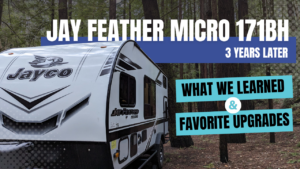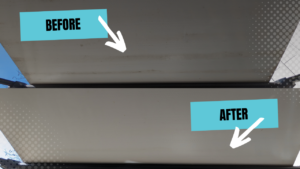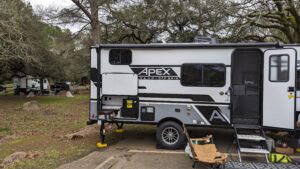We’re going to compare our Jay Feather Micro trailer to an Ember travel trailer. Now, when we were actually looking for our trailer, the Ember models were not out yet, or at least we hadn’t heard of them yet. They came out right after we bought our trailer and we immediately liked a lot about the Embers. Now with that being said, there are also a few things that we like better about the trailer that we have. So we thought we’d go through and do a comparison of how the Jay Feather Micro compares to the Ember travel trailers.
Rogina Roaming is supported by its audience. When you purchase through links on our site, we may earn an affiliate commission at no extra cost to you.
We are specifically going to be comparing our Jay Feather Micro 171BH travel trailer to the Ember 170MBH. The reason why we’re comparing those two specific models is because first of all, the 171 is the model that we have, so that’s what we’re most familiar with. And then in Ember’s lineup, they have several different models, but the 170MBH is the model that is most comparable to our 171bh. So that seemed like the best way to compare apples to apples.
Floor Plan
First are the floor plans. The floor plan on the Ember has a Murphy bed. A Murphy bed is a bed that folds up and then underneath is a couch. The Ember floor plan also has an additional sofa. And the sofa does have a spot where you can hook in a table. There is not a dedicated dinette. There is a sofa and a Murphy bed.
In the Jay Feather Micro, there is a permanent bed up front and then there is a dinette. There is no couch.
Now, when we were looking at trailers, I am positive that we would have said that Ember floor plan is much better. We really like the idea of a Murphy bed and putting our bed away during the day and then having some extra seating area. And the idea of the couches seemed a lot more exciting than having a dinette. It just seemed like we would have a lot more use out of that space and there would be more walking space.
After actually using the floor plan in the Jay Feather Micro, the dinette and permanent bed is definitely our preference. We really like having the bed there all the time and the dinette turns out to be very useful in such a small space. It acts as additional counter space.
The dinette is where I do a lot of the chopping and prep work for all of our different meals. If we’re doing dishes, that’s also where I normally put the drying rack, so we use that quite a bit. It’s also really nice for the kids. They will often eat breakfast there and use the space for coloring.
Now I know you can attach a table to the sofa in the Ember and use it as a dinette. But to me, if you need some counter space, if you need to set something down, you often don’t have time to first go and get a table and put it out there. Plus, when the table is out, there isn’t as much walking space. So it’s really nice just to have that extra counter space from the dinette available whenever you need it.
There has also been a time when we were camping with another group and it started raining and we wanted to all come in the trailer. Now with the layout in the Jay Feather Micro, we were able to make it happen. We could put three kids on the bed, they were all watching a movie, and four adults sat at that table and played card games. It did get a little bit cramped, but we were able to pull out the storage cubes underneath the bed and one of the adults just sat on that cube while three others sat comfortably at the dinette. It worked out for four adults and three kids to hang out in here for an evening.
If we had the Ember floor plan, there’s no way that that would have worked out because even if we turned the Murphy bed into a bed and put all three kids on there to watch a movie, then we only have one couch for four adults and there’s not going to be a way for that to comfortably work out. If you keep the bed up, then you’ll have two couches and the four adults would be fine, but then the kids wouldn’t be entertained.
So even though the idea of the Murphy bed and the couch seems really great, and that is actually what we were looking for when we were first looking for a trailer, it turns out the bed with the dinette is just more practical and gives us more options.
Even with that being the case, I still wouldn’t say a hundred percent that the Jay Feather is the winner of the floor plan versus the Ember. They’re both really good floor plans and I think it just comes down to what you need and what makes sense for your family.
Carrying Capacity
The next item is the carrying capacity. So how much cargo you can carry in the trailer. And that goes to Ember. Ember definitely wins that one.
The dry weight of these two trailers is pretty much the same, but the caring capacity of the Ember is about 300 pounds more than the Jay Feather Micro.
Now that we have a trailer, I know that having extra caring capacity is really nice so that you can do more battery upgrades, more solar upgrades and not have to worry about adding all that extra weight to your trailer.
Windows
Another win for the Ember is they all have European style windows. So the European windows are really cool because you can open them all up completely if you’d like to get breeze in there, but then they also have it so in one direction you pull up a shade and then in the other direction you could pull down a blackout curtain. So it’s really nice because you could have a shade, you can have a curtain, you could have the window fully open. It gives you a lot of options.
The windows in the Jay Feather Micro are fine, there’s no problem with them. You just don’t have as many options as you have with the European windows.
Front Vent Fan
Okay, now for a win for the Jay Feather Micro, the Jay Feather Micro has a ceiling fan right in the front area. It has a big Max air vent fan and it’s 12 volt, so it’s really nice when you’re dry camping or camping off grid. You could just turn the fan on and it really helps with the airflow and circulation in.
None of the current Ember models have a vent fan in the front area. Now they do have a stargazer skylight and that does look pretty cool. Although it does give you access to airflow, there is no fan or anything that’s actually pushing air out.
So because of that, I gave the pro to the Jay Feather Micro for this one.
Storage
Okay, another pro for the Jay Feather Micro is there seems to be more usable storage. So in the Jay Feather Micro, all of the storage areas have really nice cabinet doors. There are storage areas on the Ember above the bed, but there are no doors on that. So, that’s really going to limit what you can store in there.
There’s a couple different areas in the Ember where they have spots that are there, so you can store stuff, but there are no doors. So I really like in the Jay Feather Micro that you get a lot of storage areas, but then there’s also doors, so it’s just going to make it a lot easier to pack in a way that you could travel.
Dimmable Lights
A plus for the Ember is the Embers come standard with dimmable lights. That is not a necessary feature, but it is really nice to have.
It is an option in the Jay Feather Micro, but you have to get the optional upgrade of the Jay Command setup, and we don’t have that. There are times when we’ve been camping and when it gets late at night, I could definitely see how it would be nice to have some dimmer lights.
Truma Combi
Another big plus for the Ember is it comes with a Truma Combi water heater system. The Truma Combi is both the hot water system and it’s also the furnace, so it’s those two combined into one. And what’s really nice is it’s a tankless hot water heater, so there’s no maintenance required. It also puts your whole wet bay area in a pass through. So it’s just nice that it’s tucked away. You can lock it up if you want to, and the system is maintenance free.
Showermiser
Another pro for the Ember is it comes with the showermiser system in the shower. What that does is it lets the water circulate in the shower as it’s heating up so you’re not wasting water when you’re trying to warm up your shower.
Tongue Upgrades
Another pro for the Ember, something that we really liked about it is all of the tongue upgrades. So on the tongue of the Ember, they have a really nice tongue box that holds the propane tanks. You can put your batteries out there if you don’t have lithium batteries, if you don’t need them to be inside, and it also just gives you a little bit more storage space out there.
They’ve also changed how the jack on the front tongue works, so you can actually open up your tailgate. There’s nothing there to interfere with it, and that’s pretty cool.
Pitched Roof
Another plus for the Ember is they have a pitched roof. The roof is intentionally at an angle, and that’s designed for water runoff, which is really nice. When we park the trailer, when we’re not at a campsite, we intentionally don’t have it leveled because otherwise water puddles on the roof. So we put our trailer at an intentional angle to try and get some runoff on our own, but it’s nice that they thought of that and it’s built into the design of the Embers.
Suspension
Another really big pro for the Ember trailers is the suspension. It has an independent suspension system, so the embers are designed to be able to go off-road and they’re not going to have any problems with the bumps.
Wheel Chocks
Embers also have built in wheel chocks. Even for these single axle trailers, they’ve created a way that you can chock your wheels with a mechanism that’s built into the trailer. It’s just a really cool unique feature that the Embers have just to make it that much easier to keep your trailer where you want it.
TPMS
The tires on the Ember trailers also come standard with a TPMS system. This is another item that you can get if you get the Jay Command system on the Jay Feather Micro. We did not. So we added a TPMS separately and it wasn’t a huge issue or anything, but it’s nice that it’s just included in the Ember. One less thing that you have to think about or worry about.
Pass Through Storage
Now with the Murphy bed in the Ember, the pass through space is very, very limited. I initially thought that the pass through space that we have in the Jay Feather Micro was small, but compared to the pass through in the Ember, there’s lots of space. The openings are pretty similar, but in the Ember there’s this big area that’s not going to be able to be accessed in the pass through because that’s where the Murphy bed sits. So the pass through area in the Jay Feather Micro is actually a lot more usable.
Storage Door Screen
So the next one is pretty specific to these models, but on the Ember 170mbh, which is the bunk house with the storage door, just like the Jay Feather Micro 171bh, the storage store on those bunks also has a screen door.
The one in the Jay Feather Micro is just the door. There’s no screen, it’s the same quality, the same friction hinge and everything as the front door, but there’s no screen.
And the reason why the screen is nice on the Ember is because during the day, if you’re trying to get a cross breeze and cool down your trailer, especially when you’re dry camping, you can’t just sit there and use the AC. It’s really nice that you can have a screen open in the front and the back. So that just seems like that would be a really good way to try and get some airflow and cool down the trailer.
Ladder
One of the things that I really did not like about the Embers is they don’t come with a ladder. There is an optional ladder that you can get, but to me, the big issue isn’t the fact that the ladder is optional, but the type of ladder that it includes.
So with a Jay Feather Micro, we have a ladder that is attached onto the back. With the Embers, there are a couple of hooks that you could kind of put the top part on, but the ladder is loose. It’s a separate item. And the reason why I don’t like that as much is because when the ladder is attached to the trailer, it is very stable. You shake that thing, it’s not moving around, you can go up there by yourself. There’s no need for anybody else to help hold the ladder or anything like that. It’s just there. So it’s convenient, it’s really stable, and it also acts like a rack. We don’t actually go up the ladder all too often, but we do use it to hang things and to dry towels. It’s just a nice extra space that we have back there.
Receiver Hitch
A nice thing about Ember is there’s actually a receiver hitch on the back of the trailer. It’s rated up to 300 pounds for you to carry just a little bit more back there. And that’s not something that’s very easy to add onto a trailer because it relies on the frame and the body of the trailer being able to support that extra weight.
Tank Heaters
Another thing that’s really cool about Ember is they come standard with 12 volt tank heaters. That’s another item that can be added as an option to the Jay Feather Micro, but with Ember it comes standard. But more than that, the trailer is actually rated for full four seasons. It’s rated from zero to a hundred degrees, so you know that you can camp with the Ember when it is very cold out. It’s just nice that that’s tested and you know for sure what it can handle.
Azdel
Another pro for Ember is the Azdel siding. Now, they both have Azdel siding, the Jay Feather Micro has it on the sides and the back, but the Ember also has it on the front and the roof.
The roof of the Jay Feather Micro is a rubberized TPO roof, whereas on top of the Ember it is actually Azdel.
Outdoor Kitchen
A plus for the Jay Feather Micro is it comes with the Jay Port and a griddle. Ours came with the Blackstone. I’ve heard that the more recent models have come with a different brand, but even if it didn’t come with the Blackstone model, it still comes with the Jay Port system that supports a 17 or a 22 inch griddle connected directly to the trailer. And it’s really nice. We do all of our cooking outside, so we just love having a spot that’s already dedicated to do the cooking out there.
On the Embers they do have a quick connect spot out there, but that it doesn’t come with any kind of table or any kind of way to mount a griddle. And it doesn’t come with a griddle. You can get one as an option, but there isn’t a designated spot for it. There’s no table or any accessory to be able to connect it to your trailer. On some of their larger models, they do have a Camp Kitchen, but like I said, in this article we’re looking at the 170mbh, and in that particular model, there is no Camp Kitchen.
Solar
A big plus for Ember is it comes standard with solar. So the Jay Feather Micro comes standard with Solar Prep, so it is ready for you to get a solar package and put it on, but the Ember actually comes with the panels. The Ember comes standard with 200 watts solar on the roof and a thousand watt inverter. So that’s a really cool setup just to start with. And then they also have packages that you can use to upgrade to lithium batteries and add additional solar panels.
When we first purchased this, that would’ve been a huge selling point for us. We definitely wanted solar and the fact that you can get it already set up for you is really, really nice. Now that we have had this trailer and we went through all of the work of figuring out what solar system we needed, what worked best for us and installing it all, now we really like knowing exactly how it works and knowing that we have a system that’s designed perfect for us and we really like all of the components that we use. Everything works out really well for us on how we did this setup, but it is really nice that Ember has the option that if you want to just pay them to do all of the Max Solar package, you don’t even have to worry about that. But even if you didn’t do all of the extra lithium stuff, they still win on the solar side because standard, they’re going to give you a panel, a small inverter, and the solar controller, everything that you need to get started.
Solar Display
One area where the Jay Feather Micro really wins in solar versus the Ember is the Ember’s controller that you can use to see where your battery levels are at and how your solar system is doing. That display is in the pass through, whereas in the Jay Feather Micro, it’s inside, near the bunks between the bunks and the bathroom.
It is really nice to be able to access that easily and see what your batteries are at specifically late at night. Most of the time that we’re wondering how our batteries are doing, it’s when we’re in here for the evening and we’re debating should we turn on the tv? Do we need to conserve power? It wouldn’t be that great to have to go outside and open the pass through to check on our battery level, and you can use a Bluetooth app to see it. But when we’re camping, we really don’t like to rely on our phones. We like to be able to have an easy to access display in the trailer that we can monitor and see what’s going on with everything.
Price
And the last big topic to talk about when we’re comparing these two trailers is the price. So the Ember has a lot of really, really, really cool features, but all of that comes at a price. So the MSRP on the Jay Feather Micro is around 25K. The Ember is around 50K. So there is a big difference between the price of these two things. You get a lot with the Ember, and a lot of that is stuff that wouldn’t be easy to add onto a trailer. A lot of it is structural and the suspension and the Truma Combi. All of that would be very difficult to add into this trailer, but you’re also paying a considerable more amount of money to be able to get all of that stuff.
So when it comes to price, the Jay Feather Micro definitely has the better price point.
Conclusion
Now, to be honest, I am kind of glad that Embers were not a consideration when we were looking for our trailer because I don’t actually know which one of these we would have decided on. The Ember, like I said, has a lot of really awesome features, but all of those features come at a price. The Jay Feather Micro has been awesome. We absolutely love this trailer, and now that we have this trailer, we certainly would not sell it to go and get the Ember trailer that’s basically the same model. We really like this one. We’ve made it work for us and we’re very happy with it. I can see maybe someday if we were ever looking for a different trailer, looking at one of the different Ember models and maybe going that direction.
But like I said, I really don’t know where I’d land on this because the difference in features versus the difference in price is pretty big.
Any trailer that you get, you’re going to want to make it work for you. There’s nothing that you’re going to buy that it’s going to be perfect and done. You’re always going to want to tweak things, fix things, change things to make it work best for you and your family. So I guess the bottom line is there’s not a bad choice here. Both of these trailers are really, really great choices. So just do what makes the most sense for your family. I hope this helps.



